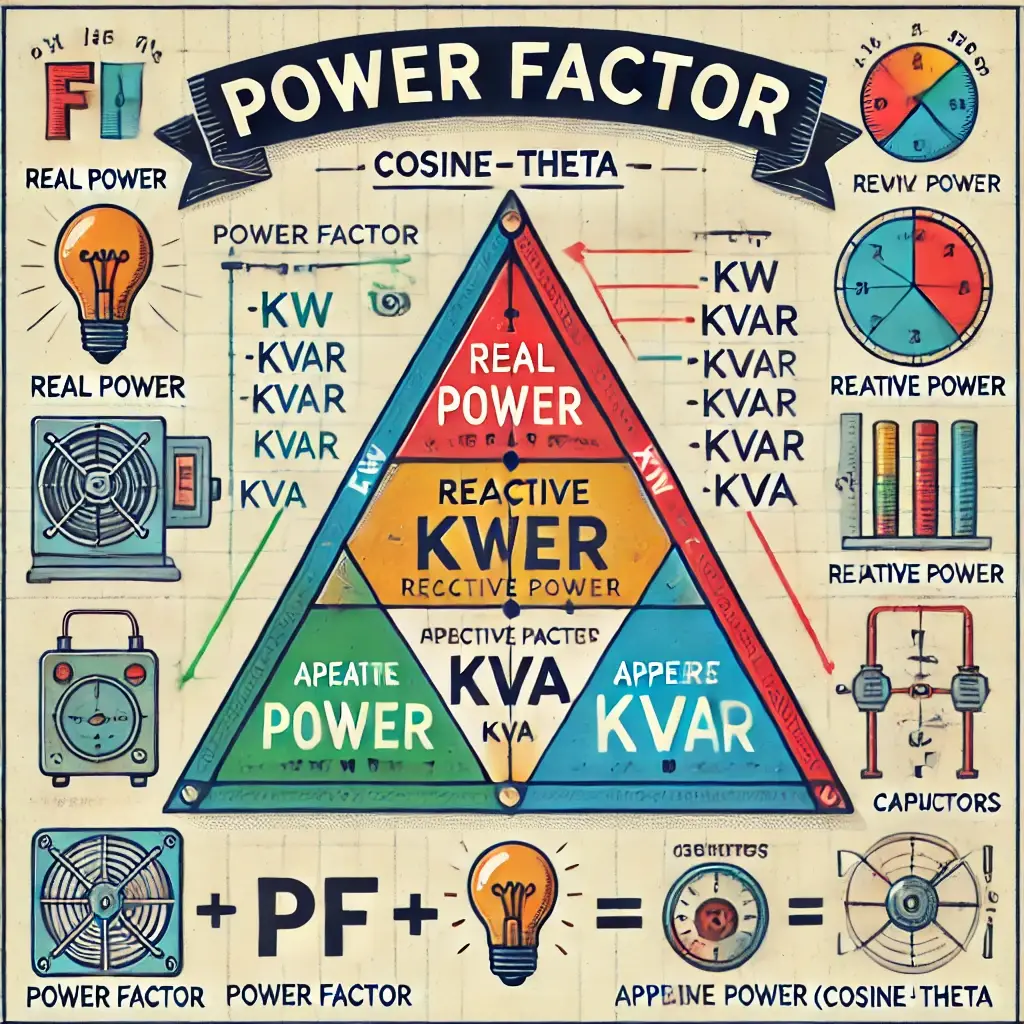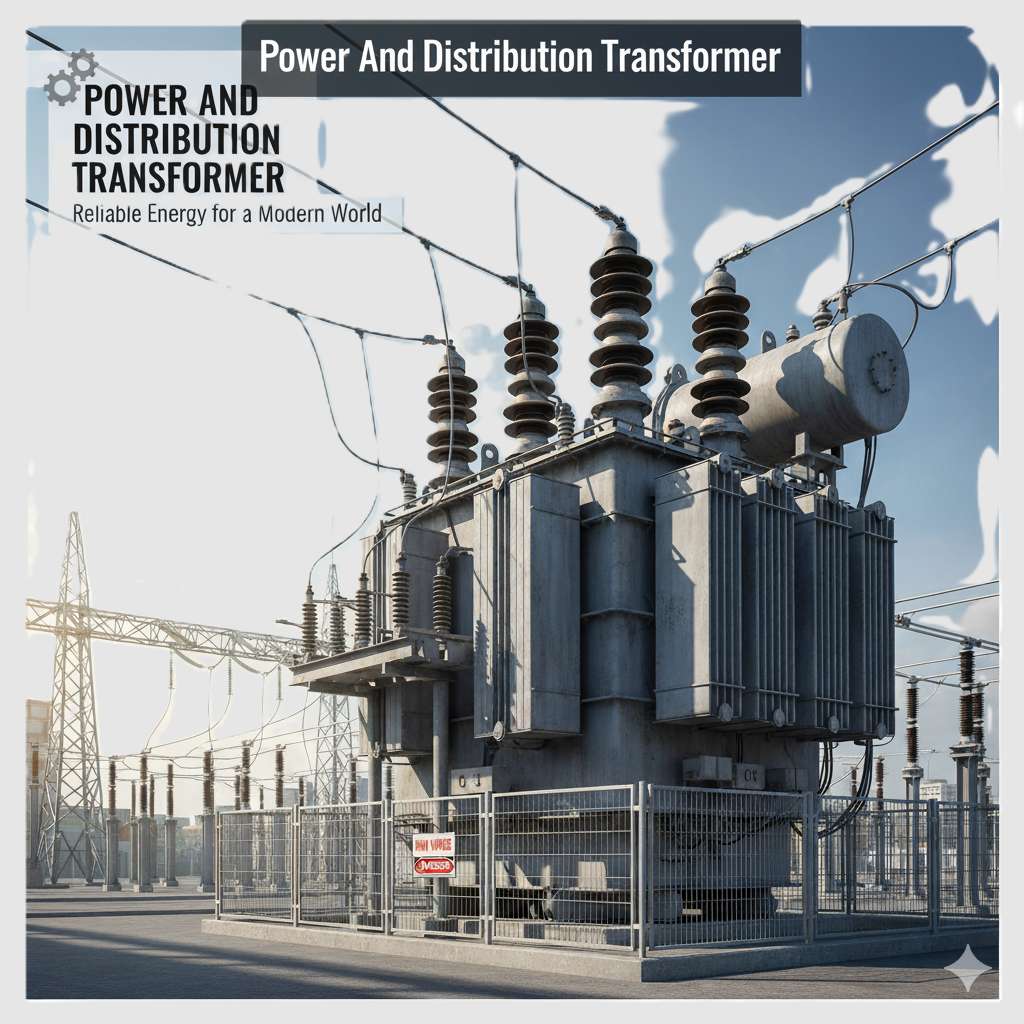Table of Contents
Definition
A DC generator is a special type of machine. It takes mechanical energy—like the energy we get from a moving fan or a turning wheel—and changes it into electrical energy, which we can use to light bulbs, run fans, or charge batteries.
But how does this magic happen?
It all starts with something very powerful—a magnetic field. This invisible force acts like a bridge between the moving parts of the machine and the electricity it creates.
This idea comes from a very important rule in science called Faraday’s Law of Electromagnetic Induction. It simply says: When something moves in a magnetic field, electricity can be made.
In fact, almost all electrical machines—like motors, transformers, and generators—use magnetic fields to work. That’s why it is important to first understand what magnetism is and how it helps us make electricity.
Before we dive deeper into Faraday’s law and how a DC generator works, let’s first take a moment to understand some simple things about magnetism and electromagnetic energy. Once we know that, everything else will start to make sense easily.

DC Generator: Working Principle of Operation
A DC Generator works on a very smart rule of nature — something discovered by a scientist named Faraday. He found out that when a wire moves through a magnetic field, electricity gets created in the wire. This is called electromagnetic induction.
Let’s understand it step by step with an easy example:
Imagine This
Think of two strong magnets placed opposite each other — one has a North pole and the other has a South pole. In between them, we place a round drum (like a small cylinder) that can spin around. This spinning part is called the armature.
Now, we take a simple copper wire, bend it into a rectangle (like a square with long sides), and fix it on the armature. Two sides of this wire (let’s call them AB and CD) sit inside grooves or slots on the surface of the drum. The other two sides (BC and DA) just connect them.
What Happens When We Rotate It?
As the armature starts spinning, the wire sides AB and CD move through the magnetic field — they cut across the invisible lines of force between the magnets.
This movement creates electricity inside the wires because the magnetic field is being “cut” by them. The faster we spin the armature, the more electricity is generated. This electricity is called EMF (Electromotive Force), or simply voltage.
The two sides AB and CD create voltages that add up, because they face opposite magnetic poles. That’s why these two sides are called the active parts of the coil. They are the parts that really “generate” the electricity.
The other sides (BC and DA) don’t cut the magnetic field, so they don’t help in making electricity, but they help connect the wire into a full loop.
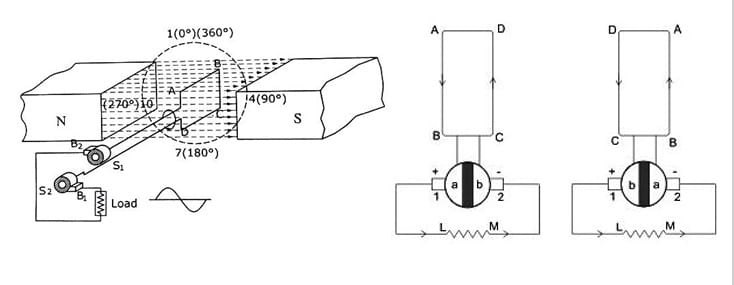
How Electricity is Taken Out from a Rotating Coil
When electricity is made inside a coil, it can only be used if we connect something to it — like a small bulb or a resistor (we’ll call it R). But here’s the problem: the coil keeps rotating, and the bulb is not moving. So how can we take the electricity from a moving coil and give it to something that is still?
To solve this, we use a special setup. In DC machines, we use a part called a commutator, and along with it, we use brushes. These two work together like a team to transfer the electricity safely. We’ll learn more about commutator and brushes a little later.
But before that, let’s understand this idea in a simpler way.
Let’s say we don’t use a commutator for now. Instead, we use two shiny copper rings called slip rings. These rings are fixed tightly on the rotating shaft, but they don’t touch each other, and they don’t let electricity pass into the shaft. They are insulated.
Now, the ends of our coil (we’ll call the coil ABCD) are connected to these slip rings. One end (A) goes to slip ring X1, and the other end (D) goes to slip ring X2.
Next, we place two small black blocks called carbon brushes. These brushes sit on the slip rings, touching them lightly. The brushes don’t move, but because they touch the spinning slip rings, electricity can flow through them.
We now connect our resistor R (our electric load) to the two brushes. That’s how the electricity comes out from the rotating coil and reaches our resistor.
Now, we rotate the coil using a motor (called a prime mover). When the coil spins inside the magnetic field made by the North and South poles, the wires of the coil cut through the magnetic lines. This action causes a change in the magnetic link — we call it flux linkage.
According to Faraday’s Law, whenever magnetic flux changes, an emf (electromotive force) is created. This emf is what makes current flow. And the faster the change in flux, the more emf is generated.
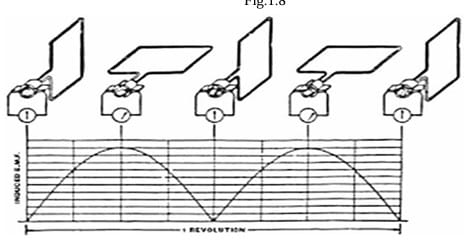
In short:
- A rotating coil makes electricity,
- Slip rings and brushes help us take that electricity out,
- And the faster the coil spins, the more electricity we get.
This is how electric power is transferred from a rotating coil to a still object like a bulb, fan, or any other electric device.
How Electricity Is Made in a Generator
Imagine you have a coil made of wire. When this coil is moved inside a magnetic field, electricity starts to flow in it. This is not magic — it’s science! Let’s understand how it happens in a very simple way.
What Happens Inside the Coil?
- Inside the coil, there are many turns or loops of wire.
- There’s a magnet creating something called magnetic flux — you can think of it like invisible lines of magnetic force.
- When the coil moves through these magnetic lines, the coil “cuts” the lines.
- This “cutting” changes the flux linkage — which means how many magnetic lines are going through the coil.
- This change creates electricity — which we call emf (electromotive force).
Now, a Very Simple Equation
We can write this like:
Emf = Change in flux linkage / Time
This means:
If the flux (magnetic lines) change fast, more electricity is produced.
If the coil has more turns, even more electricity is made.
We also use a minus sign (–) in the formula. That’s because of something called Lenz’s Law, which says nature always tries to fight the change. So, the current flows in a direction that opposes the change in magnetic flux.
Two Ways to Understand This
There are two simple ways to look at how this electricity is made:
- Moving Way (Dynamic) – When the coil is actually moving inside the magnetic field.
- Still Way (Static) – When the coil stays still but the magnetic field changes.
In both cases, the result is the same — electricity is made.

DC Generator Working Principle All Roles
Coulomb’s Law of Magnetic Force
When we bring two magnetic poles close to each other, they feel a push or pull — this is called magnetic force.
First Law of Magnetism
Like poles repel, unlike poles attract.
This means:
- If we bring two north poles or two south poles near each other, they push away.
- If we bring a north pole and a south pole near each other, they pull together.
Second Law of Magnetism
The force between two magnetic poles depends on:
- How strong the poles are.
- How far apart they are.
In simple words:
- If the poles are stronger, the force is more.
- If the poles are closer, the force is more.
The force becomes weaker when the poles are weaker or farther apart.
Formula:
F ∝ (m₁ × m₂) / d²
Where:
- m₁ and m₂ are the strengths of the two poles.
- d is the distance between them.
Magnetic Effect of Electric Current
Electric current and magnetism are best friends!
When electric current flows through a wire (or conductor), it creates a magnetic field all around it. This is called the magnetic effect of current.
Let’s understand it in a very easy way:
- More current = Stronger magnetic field
When more current flows, the magnetic effect becomes stronger.
Less current means a weaker magnetic field. - Closer to wire = Stronger field
The magnetic field is strongest near the wire.
As you move away, it becomes weaker. - Direction of magnetic field
The direction of the magnetic field depends on the direction of the current.- If current goes in one direction, the magnetic field spins one way.
- If current goes the other way, the field spins the other way.
Just hold the wire with your right hand:- Thumb points in the direction of the current.
- Fingers curl in the direction of the magnetic field.
- Shape of the magnetic field
The magnetic field makes circles around the wire.
These circles are called magnetic lines of force.
The shape and direction depend on how the current flows.
Right Hand Thumb Rule
Imagine you are holding a straight wire (conductor) in your right hand.
Now, point your thumb in the direction where the electric current is going.
When you do this, the way your fingers curl around the wire will show you the direction of the magnetic field around it.
That’s it!
This is called the Right Hand Thumb Rule.
👉 Thumb = Current
👉 Fingers = Magnetic Field direction
It’s just like magic — your hand tells you the hidden path of magnetism.
Cross and Dot Notation
To show the direction of current, we sometimes use cross (×) and dot (•) signs.
- Cross (×) means the current is going away from you — just like seeing the tail of an arrow flying away.
- Dot (•) means the current is coming towards you — just like seeing the tip of an arrow coming at you.
Think of it like this:
🚀 If you see the tail, the rocket is going away — use a cross (×)
🚀 If you see the tip, the rocket is coming at you — use a dot (•)
This makes it super easy to understand the direction of current in diagrams.
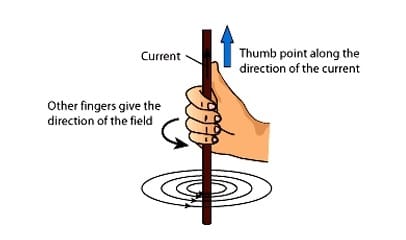
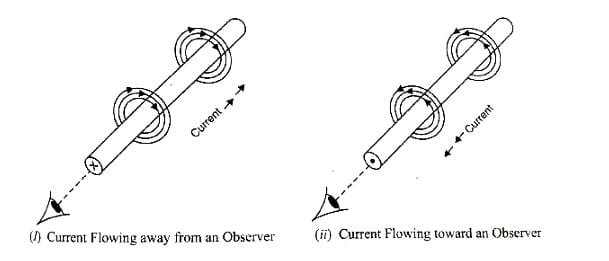
Faraday’s Laws of Electromagnetic Induction
And how a DC Generator works on it
Introduction (in simple words):
Let’s imagine you have a magnet and a coil of wire. Now, if you move the magnet near the coil, something magical happens — a tiny electric current starts flowing in the coil! That’s because of something called Faraday’s Laws of Electromagnetic Induction.
This idea is so important that the machines we use to generate electricity — like a DC generator — are all based on it.
Faraday’s Experiment (easy to understand):
Think of a coil of wire, connected to a device that shows current. This device is called a galvanometer.
Now, let’s do a small activity in your mind:
- Take a magnet and move it towards the coil.
👉 You’ll see the needle of the galvanometer moves to one side. That means current is flowing. - Now pull the magnet away from the coil.
👉 The needle moves the other way. That means the current is still flowing, but in the opposite direction.
This shows that when a magnet moves near a coil, it creates electricity in the coil — this is called induced current.
But how? Because the magnet’s movement changes the magnetic field around the coil, and this change creates an EMF (electromotive force), which makes the current flow.
Faraday’s First Law (simple meaning):
“Whenever the magnetic field around a coil or wire changes, electricity (EMF) is created in it.”
In short: Change in magnet → Electricity in coil
Faraday’s Second Law (easy meaning):
“The faster the magnetic field changes, the more electricity (EMF) is created.”
In simple words: If you move the magnet quickly, you get more current. If you move it slowly, you get less current.
The formula for this law is:
e = – N × (dɸ/dt)
Where:
- e = EMF (how much electricity is created)
- N = Number of turns in the coil
- dɸ/dt = How fast the magnetic field (flux) is changing
The minus sign (–) is from Lenz’s Law, which tells us that the coil always tries to oppose the change that created the current.
DC Generator and Faraday’s Law:
A DC generator is a machine that turns motion into electricity. It works because of Faraday’s laws.
Inside the generator:
- A coil rotates in a magnetic field.
- As the coil spins, the magnetic field around it changes.
- This changing field creates EMF (electricity) in the coil.
- That’s how the generator gives us direct current (DC) electricity.
So, whenever you switch on a fan or light that runs on DC, remember — it’s all thanks to Faraday’s magical law!
DC generator works on the principle of Faraday’s law of electromagnetic induction.
Faraday’s experiment:
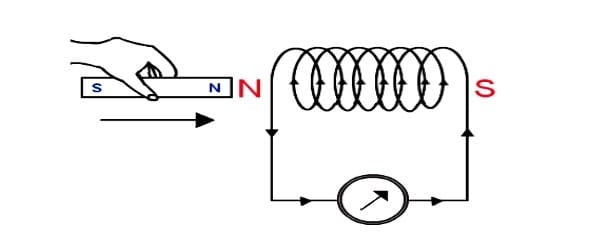
Direction of Induced EMF and Current
When a magnetic field comes in contact with a wire or coil and there is some movement, an electric current is automatically produced.
We can find the direction of this current in two easy ways:
1. Lenz’s Law
Lenz’s Law says:
“Whenever a current is produced on its own in a coil, it will always oppose the very cause that created it.”
This means that if the magnetic flux (magnetic field lines) passing through a coil is increasing, then the current produced will try to stop that increase.
It’s just like if someone is trying to force a door open and you’re trying to push it closed – it works against the change.
2. Fleming’s Right-Hand Rule
This rule helps us find the direction of the current, especially when a wire moves in a magnetic field — like in a DC generator.

How to use it:
- Raise your right hand.
- Stretch your thumb, index finger, and middle finger so that all three are at right angles to each other (like the corner of a cube).
Now look:
- The index finger shows the direction of the magnetic field.
- The thumb shows the direction of the motion of the conductor (wire).
- The middle finger shows the direction of the induced current.
That’s it! Very easy to remember.
How is EMF Produced?
Whenever a wire cuts through a magnetic field — or a magnetic field cuts through a wire — an EMF (Electromotive Force) is produced in the wire.
To generate EMF, we need three things:
- A magnetic field
- A conductor (like a wire)
- Motion between the two – either the field moves or the wire moves
If any one of these is missing, EMF will not be produced.
EMF Equation of a DC Generator
Imagine you have a DC generator, which is a machine that changes motion into electricity. Now, to understand how much electricity (or EMF) this generator creates, we use a special formula.
Let’s break it down step by step.
📘 The Formula:
e=(ϕ×P×N/60)×(Z/A)
Where:
- e = EMF (the voltage produced, in volts)
- ϕ (phi) = Magnetic flux (how strong the magnet is)
- P = Number of poles (magnets) in the generator
- N = Speed of rotation (how fast the armature spins, in rounds per minute)
- Z = Total number of conductors (wires that cut the magnetic field)
- A = Number of parallel paths in the winding
Types of Induced EMF
EMF can be produced in two ways:
1. Dynamically Induced EMF
When a wire moves inside a magnetic field, the EMF that is generated is called Dynamically Induced EMF.
This happens because of movement.
Example: DC Generator
2. Statically Induced EMF
If the wire is not moving, but the magnetic field is changing or moving, then the EMF generated is called Statically Induced EMF.
Examples: Transformer, AC Generator (Alternator)
Basics of Electromagnetism 🌟
🔹 Magnet and Magnetism
A magnet is a special object that can pull things like iron or steel towards it.
This magical pulling power is called magnetism.
Have you ever seen how a fridge magnet sticks to the fridge? That’s magnetism in action!
🔹 Magnetic Field
Around every magnet, there is an invisible area where its power can be felt.
This area is called a magnetic field.
If you bring an iron nail close to a magnet, it starts moving before even touching it —
that’s because it has entered the magnet’s field.
🔹 Magnetic Flux
The magnetic field is made up of many invisible lines.
The total number of these magnetic lines coming out from a magnet is called magnetic flux.
It is written as the symbol ɸ (phi) and its unit is Weber (Wb).
Just like how water flows in a pipe, magnetic flux flows through a magnetic material.
🔹 Permeability
Different materials allow magnetic flux to pass through them more or less easily.
This ability is called permeability.
It tells us how easily a material can carry the magnetic lines.
It is written by the letter µ (mu), and the unit is Henries per meter (H/m).
There are two types of permeability:
- µ₀ (mu naught): Permeability of empty space or air
- µᵣ (mu r): How much better or worse a material is compared to air
The formula is:
µ = µ₀ × µᵣ
👉 Note: Permeability is just the opposite of something called magnetic reluctance, which means resistance to magnetic flow.
🔹 Magneto Motive Force (MMF)
To push water through a pipe, we need pressure.
Similarly, to push magnetic flux through a magnetic path, we need a force.
This force is called Magneto Motive Force, or simply MMF.
Just like a battery pushes electric current, MMF pushes magnetic flux.
It depends on:
- The number of wire turns (N)
- The electric current (I) flowing through them
The formula is:
MMF = N × I
Its unit is Ampere-Turns (AT).
FAQ
I am an Electrical Engineer with qualifications in ITI, Diploma, and B.Tech. I have worked as an ITI college instructor for 3 years and have over 5 years of hands-on experience in the electrical field. The information shared on this website is based on trusted electrical engineering textbooks such as P.S. Bimbhra, B.L. Theraja, V.K. Mehta, and real-world practical experience.


